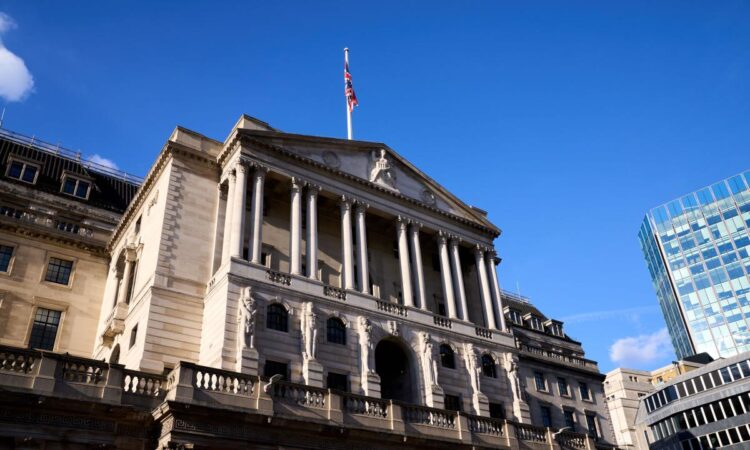
Money markets are narrowly betting that the Bank of England (BoE) will cut UK interest rates this Thursday, despite recent data showing sticky services inflation.
Threadneedle Street is set to make its next decision this Thursday, with odds standing at just over 58% for a 0.25% cut, and a likelihood of a cut by September at around 90%.
“The August decision is, perhaps, one of the toughest MPC decisions to forecast…in recent memory,” Michael Brown, senior research strategist at Pepperstone, said.
UK interest rates are currently at 16-year record highs of 5.25% and the move would be the BoE’s first interest rate cut in over four years.
According to a Reuters poll, the majority of economists expect the monetary policy committee (MPC) to reduce interest rates at their August meeting. The survey, conducted between 18 and 24 July, showed that over 80% of economists (49 out of 60) anticipate the BoE will implement the rate cut.
Read more: When will interest rates fall and what should you do?
At the last meeting only two of the nine voting members called for a reduction in the Bank rate, and some of those voting for a hold were keen for more proof that inflationary persistence is cooling.
Analysts at IG said: “While softer labour market data support the rates market pricing in 12.5 bp (50%) of a 25 bp rate hike at its meeting next week, sticky inflation suggests that rates need to stay higher for longer. However, the case for a rate cut is building and is expected to be a line-ball decision.”
Meanwhile, analysts at Nomura said: “The Bank of England faces a tough decision. But we think it will deliver the first cut of the cycle”.
Benjamin Jones, director of macro research, Invesco, said: “The UK inflation picture today is better than many other developed markets giving the Bank of England an excuse to cut on 1 August. If it doesn’t, it may find that inflation data make it hard to justify a rate cut later in 2024.”
However, not everyone is convinced. Ruth Gregory, deputy chief UK economist at Capital Economics said: “The economy’s recent strength and the stickiness of services inflation leads us to think that the Bank of England will wait until its September meeting to cut interest rate.”
Read more: Shop inflation steady in July as clothing and footwear prices drop
The UK’s rate of inflation remained unchanged at 2% in June, unchanged from May and partly driven by hotel prices going up. Financial markets had expected a fall to 1.9% last month.
Closely watched services inflation, which tracks categories such as hospitality, culture and housing, was unchanged at 5.7% in June, which was higher than economists’ estimates.
The largest upward contribution to inflation came from restaurants and hotels, with prices of hotels rising more than a year ago. The largest downward contribution came from clothing and footwear, with prices of garments falling in June after rising a year ago.
The core rate of inflation, which strips out energy, food, alcohol and tobacco, stayed at 3.5%.
Andrew Bailey, the governor of the Bank of England, previously stressed that policymakers need “to be sure that inflation will stay low”.
Meanwhile, Sonali Punhani, UK economist at Bank of America Merrill Lynch, said: “The data doesn’t provide clear signals that inflation persistence is beaten.”
But she added that the BoE could be willing to “tolerate and explain away” stronger-than-expected price growth and go ahead with a cut, “especially in the context of UK inflation rising again later in the year, which could make the communication around future cuts more difficult”.
The biggest obstacle to a cut is services inflation, which has become the BoE’s primary yardstick for inflation persistence,” Kyle Chapman, FX markets analyst at Ballinger Group, said. “While headline CPI is down to 2%, this is being driven by transitory effects associated primarily with falling energy prices and goods, which the bank expects to fade later in the year.
“They need to be sure that target inflation will be a sustained achievement, and the cooling required in services inflation has not materialised at the rate that the bank had forecasted in previous meetings. It currently stands at 5.7%.”
It comes as the European Central Bank (ECB) cut interest rates for first time in five years to 3.75% in June.
Borrowing costs across the eurozone were lowered from record highs of 4%, with the ECB joining the central banks of Canada, Sweden and Switzerland in cutting rates — moving well ahead of the influential US Federal Reserve.
The latest figures from Eurostat, the statistical office of the European Union, showed that eurozone inflation crept lower in June, coming in at 2.5%. However, similarly to UK inflation, price rises in services remained persistent.
The consumer prices index for the single currency bloc inched down from an upwardly revised 2.6% in May.
Read more: Trending tickers: Microsoft, McDonald’s, Greggs, Diageo
On Wednesday, the Federal Open Market Committee is expected to keep rates unchanged, holding its benchmark interest rate steady at a 23-year high of 5.25% to 5.5% when its two-day gathering ends.
All eyes will be on the details of the meeting which will serve as a platform to further tee up a monetary policy pivot as early as September.
“The Fed is moving closer to a rate cut, and its communications this week should reflect that,” said Brian Sack, head of macro strategy at hedge fund Balyasny Asset Management.
The central bank’s preferred inflation gauge now stands at 2.6%, well below its 2022 peak.
Ed Al-Hussainy, senior interest rate and currency analyst at Columbia Threadneedle Investments, said: “The Fed now has both motive and opportunity to move towards a less restrictive monetary policy stance in September. The shift in posture is driven by greater confidence that the Fed’s strategy since 2021 has effectively reduced upside risks to inflation.
“Moreover, risks to both inflation and employment are now starting to skew to the downside, despite stability in underlying economic growth and limited drag from financial conditions outside of the housing and manufacturing sectors.”
Download the Yahoo Finance app, available for Apple and Android.





